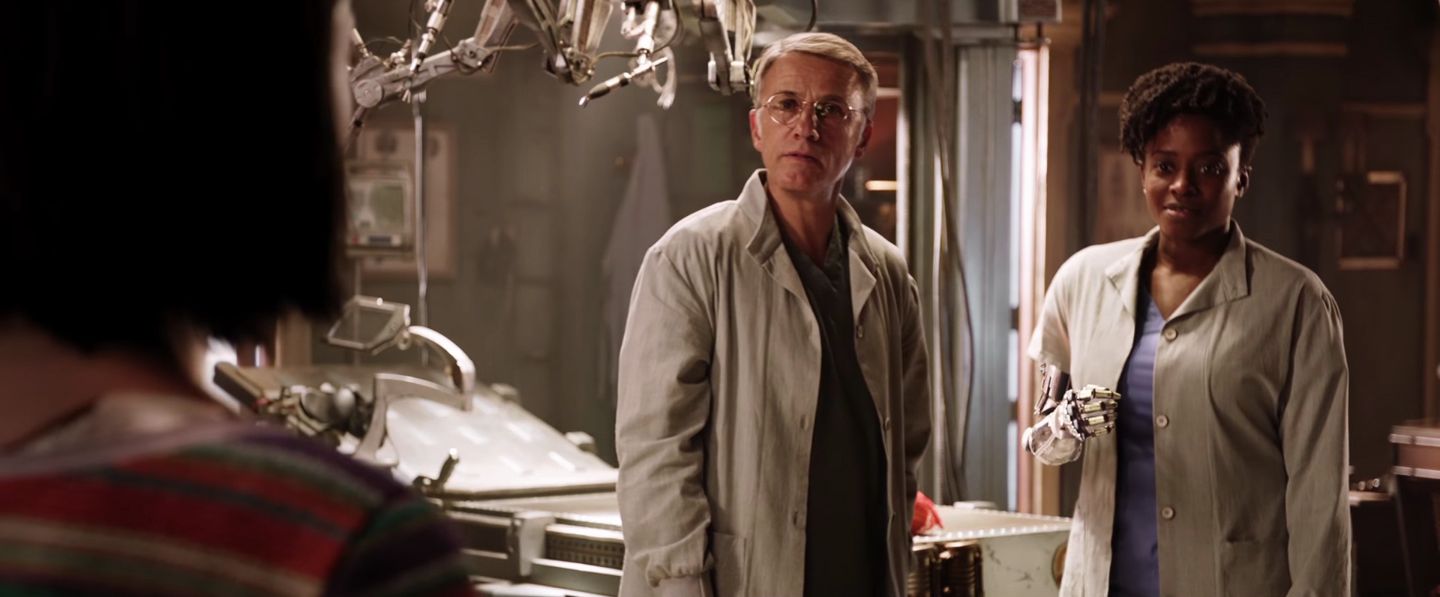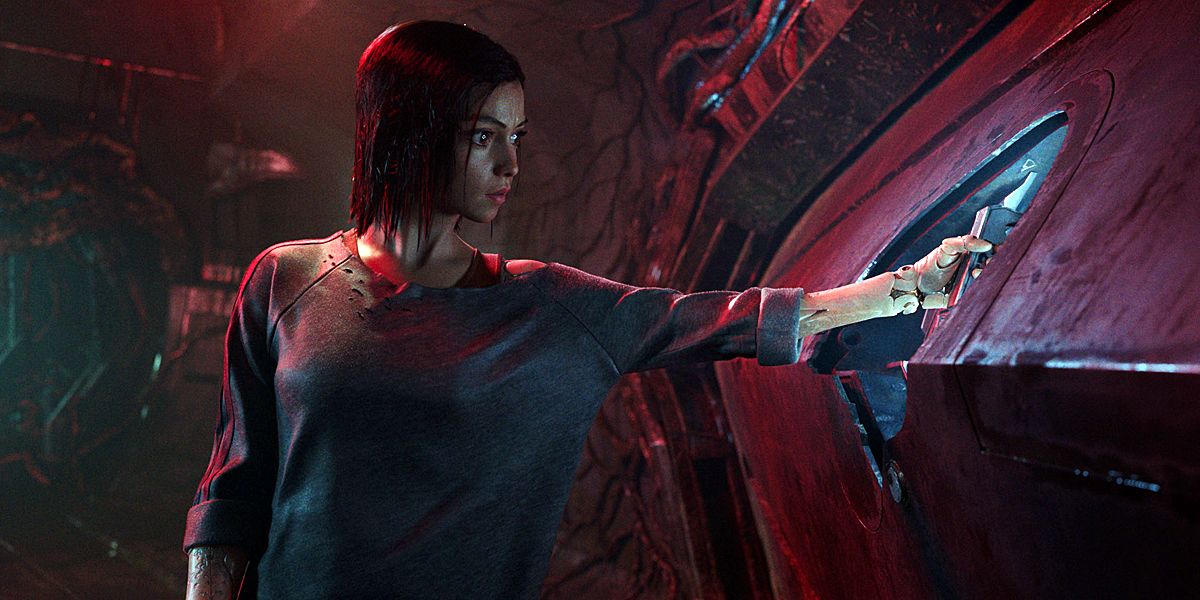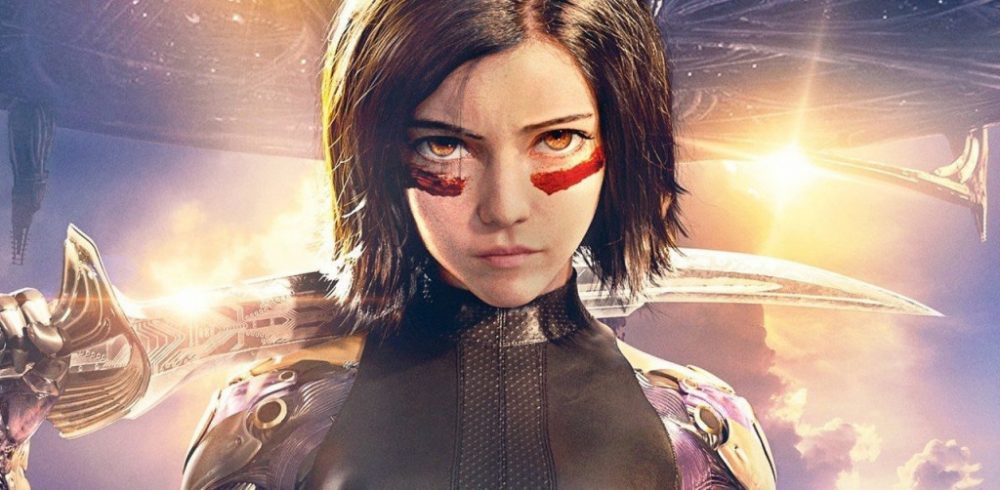Japanese Manga and Hollywood have had a rather peculiar relationship since as long as I can remember. While the former enjoys a huge following and immense popularity with loyal armies of readers and fans all over the world, the latter is only rarely rewarded with the same, while even among the ones that do, roughly half end up struggling to recover their budget. It would then appear as a paradigm that an insanely popular form of media isn’t able to conjure up the same repute or popularity for its adaptation in another, more widely consumed form of media, films. Movie adaptations of successful Manga have mostly been cases of hits and misses, and the number of truly successful manga adaptations, ones that received a fair amount of love from fans and got the cash registers ringing as well, can perhaps be counted on your fingers. Hollywood’s adaptation of ‘Ghost in the Shell’ and ‘Death Note’ should really be able to prove the point I am trying to make.

In the given scenario, ‘Alita: Battle Angel’ had a lot riding on its shoulders, and the primary reason apart from the obvious popularity of its source material would be James Cameron’s involvement, also used extensively as a marketing bout for the film, and the sizeable list of well-known faces that adorn the film’s all-star cast. Cameron here chooses to involve himself deeper with the project, as opposed to the executive producer role he has earlier limited himself to, also having written the screenplay for ‘Alita’.
What I believe the tricky part of adapting Manga comics to the screen successfully is getting the characters and setting and context right, while staying true to the graphic sensibilities of the original manga. I intentionally skip the ‘story’ part of it since that would be an essential in making any film of any nature work. In that vein, I was assured that ‘Alita: Battle Angel’ was in better hands than most manga adaptations, with the film’s director, Robert Rodriguez too bringing a certain credibility to the scene, given his success with ‘Sin City’. The film delivers too, but I’m going to hold off my verdict until the end of the write-up. For now, we delve into the legend that makes ‘Alita: Battle Angel’ what it is.
The Setting
The year is 2563, and the movie opens on a grim note stating the current time to be 300 years after “the fall”, presumably a catastrophic war that left Earth a scorching dystopia brimming with overpopulation and on the brink of exhausting its resources. As most dystopias, the economic disparity that was also, again presumably (since virtually no information is revealed about “the fall”) at the heart of the war has left two notable factions in its wake. Iron City is a giant metropolis lying in the squalor, a literal collecting ground for the trash that falls from the affluent utopia in the sky, Zalem. The architectural contrasts between the two and how they are realised and portrayed are the very distinction between a Dystopia and Utopia. However, to the makers’ credit, we never once see the city of Zalem except a few short glimpses, which Is what in my opinion helps retain some of the intrigue behind why the protagonists down under aspire to the illusive city and its riches, and why, toward the end, it seems a goal that is unattainable.
The audience sees Zalem as the residents of Iron City do, as a giant fortification of a city floating in the sky, held in its position by humongous stayed cables hooked to pylons the size of skyscrapers, which should give you a fair idea of the scale. I think it’s a reasonably good feat in fantastical thinking and its representation and rendering. Iron City on the other hand is designed to look deliberately claustrophobic and overrun with humans and vehicles. Imagine a street to be a mixture of an Asian bazar in a downtown Chicago settlement, complete with an unmistakable industrial aesthetic and retrofitting of all kinds on buildings. This is a typical Iron City street during the day, mimicking a neon drenched Hong Kong street by night. It is by virtue of this setting that the film acquires a lot of its visual character that is among ‘Alita: Battle Angel’s strengths.
Plot

Based on the nine volume manga ‘Gunnm’, ‘Alita: Battle Angel’ is the story of a cyborg struggling finding who she was before her current predicament, and who she is meant to be. Discovered as a dismembered core with a functional brain while scavenging in the scraps by Dr. Dyson Ido, a cyborg doctor and scientist, Alita is rebuilt, given a second life by Ido, and named so after Ido’s own deceased daughter. Alita wakes up to have no recollection of her past, spending some time adjusting to her life, especially the new cybernetic limbs that are part of her body now.
The outside world amuses Alita, even as Dr. Ido grows increasingly paranoid for her safety. Alita meets Hugo, a teenage boy who wishes to go to Zalem one day, and befriends him, while Hugo introduces her to the brutal sport of Motorball, wherein cyborgs with wheel like enhancements and advanced integrated weaponry fight to the death. The sport of Motorball formally takes place in a large arena at the centre of the city and is shown to draw out crowds in the hundred thousands, a testament to its popularity in Iron City, also being broadcast to Zalem. It is, however, later revealed that the sport is micromanaged by a nefarious industrialist, Vector, and that Hugo ripped away parts and enhancements from cyborgs with his group of friends to sell it to Vector as a means of earning some extra money, and being closer to realising his dream of going to Zalem one day.

Alita also meets Dr. Chiren, Dr. Ido’s ex-wife, the two having separated following their daughter’s death, and a close aide to Vector. Later, Alita discovers a wounded Dr. Ido sneaking in late one night, and follows him out of curiosity only to learn that he is a Hunter Warrior, a commissioned bounty hunter on the lookout for a target. However, the duo is ambushed by three cyborgs, and while under peril, Alita has a glimpse of what her life before being revived by Ido looked like. Back in the present following an elaborate Flashback where she is shown fighting in a war on the moon, Alita is able to show remarkable fighting skills against the cyborgs out of an instinct to save Ido from an incoming attack, killing two of the three cyborgs, and injuring the third, Grewishka. Ido later discovers that Alita was highly skilled in the ancient martial art of ‘Panzer Kunst’, and that her heart was made from an advanced technology that was capable of powering Iron City entirely for years, providing both a glimpse into Alita’s oblivious past.

The next day, Alita is able to discover a Berserker Body from a drowned ship, following another series of flashbacks and brings it to Dr. Ido, hoping for her to be transplanted into that body, only to be refused by him fearing compatibility and coupling problems. Dissed with Ido’s overprotectiveness and feeling held back, Alita registers herself as a Hunter-Warrior, later enlisting the help of other hunter-warriors in bringing down Grewishka. The proud hunter warriors, including Zapan, a humanoid with a body made mostly of metal, presumably steel, and wieding a legendary sword, scoff away at Alita’s offer, citing the absence of any contract against Grewishka and Alita’s naivety and lack of experience in asking them to do so.
In a bout to overcome their denial of her, Alita fights and overpowers almost every other hunter-warrior in the bar, even humiliating Zapan in the process, impressing many others with her martial arts skills. At that moment, Alita is challenged to a duel by Grewishka, now upgraded with spinning blades as enhancements for his arm that were stolen by Hugo from another cyborg and sold to Vector, oblivious to Alita. A visually impressive and impeccably shot battle occurs between the two which is, might I add, a complete ride in the IMAX resolution and 3D. Despite showing an almost heroic valour and putting up quite an impressive fight, Alita ends up being decapitated by Grewishka’s blades, but not before she blinds him in one eye and Grewishka being chased away by Ido, Hugo and another hunter-warrior. Alita is brought home in her current state, where Ido transplants her remains into the berserker body, and is surprised that the two immediately interface, confirming Alita’s heritage and lineage, and the part she played in ‘the fall’, being the only survivor from the resistance side, the last of her kind.
Comfortable and enhanced in her new body, Alita enters the motorball tryouts for Hugo, having fallen in love with him, believing that the winner of the tournament would get a chance to go to Zalem. However, Ido discovers that the tryouts were staged as a massacre for Alita on Vector’s orders, and tries to warn her. He race begins, and Alita is able to overpower and kill most of the perpetrators in a finely staged, relentless action sequence. She is then contacted by Hugo who seeks her help to save him from Zapan, who has framed Hugo for the murder of a cyborg, one that he committed himself. Zapan is also aware that the two love each other, and plans to use the fact to his advantage by framing Hugo and exacting revenge from Alita. Distraught, Alita leaves the race to help Hugo but is followed by the competing cyborgs in a chase through the streets and building tops. Alita arrives in time to confront Zapan, who tells her that Hugo was responsible for attacking cyborgs and stealing their body parts for Vector to enhance his cyborgs for motorball races. Alita is devastated hearing this, even as Zapan stabs Hugo with his sword, offering Alita the choice to kill him herself or let him finish Hugo according to hunter-warrior law.
However, Chiren arrives in time to deliver them from the situation, managing to save Hugo by attaching his severed head to Alita’s heart. The duo attempt to escape as the overseeing robots verify the kill from Hugo’s head, Zapan spots their bluff and attempts to stop Alita, giving her the liberty to attack Zapan as the robots construe it as a hunter-warrior attempting to steal another one’s bounty. In retaliation, Alita slices Zapan’s face off with his sword.

Ido manages to save Hugo by transplanting his head on a cyborg body, while Alita decides to continue her crusade against the system by confronting Vector. Ido also tells Alita that Hugo’s actions were guided by the false belief curated by Vector that people could buy their way into Zalem, testifying first hand since he and Chiren were disbanded from the city themselves, years ago. Moments before, it is revealed that Vector isn’t happy with Chiren’s change of heart and what she did to save Alita and Hugo. It is also revealed that Vector has been mind controlled by Nova, a powerful scientist from Zalem who had an important part to play in ‘the fall’, and who Alita remembers from her previous life, and that Chiren’s organs had been harvested as a retaliation against her unfaithful actions. Nova (through Vector) then orders Grewishka to kill Alita, who Alita easily overcomes, sliding his body into two with Zpaan’s sword that she took for herself, before stabbing and killing Vector, communicating to Nova how he made a grave mistake underestimating her.
With Vector out-of-the-way, Ido informs Alita that Hugo had eloped and was desperately trying to make his way to Zalem by climbing one of the cable tubes. Alita attempts to stop him, but her attempts are thwarted by an overlooking Nova, who sends a bladed defence ring along the tube. As the two try to jump and evade, Hugo’s body is sliced up while Alita tries to hold on to his remaining torso desperately. Hugo’s cyborg arm joints loosen with the pull, and he falls to his death as a tearful and vengeful Alita bids him goodbye. Some time later, Alita is now the star athlete of the Motorball tournament and a crowd favourite, winning which, she might finally get a chance to go to Zalem. Now seeking revenge against Hugo’s killer, Nova, knowing he’d be watching, she raises her sword to Zalem in an act of defiance as the audience cheers, and Nova is revealed to be watching her from above.
Cyberpunk

‘Alita: Battle Angel’ has been touted to be the latest entrant in a genre that has been particularly interesting to note and study for me. Within the wider realm of science fiction and intersecting narrowly with Dystopian and Futuristic cinema representations, Cyberpunk is an ever evolving subgenre with ever-changing connotations attached to it, the most common being ones where it associates itself with displaying an eclectic mix of high-end technology as a result of futuristic development, and contrasting that against the ruins of a world and a collapse of the prevalent social order left in the very wake of that futuristic development. As a result of this rather peculiar but plausible mix, more often than not, we find such films choosing the urban model of Asian cities as their filming ground.
Often accompanied by visually dazzling shots that highlight the ‘futuristic’ part of it, films of this subgenre also feature either a troubled protagonist or a grim tone, unsurprisingly also characteristic of the protagonist of a social dystopia who realises there is something wrong with the system and wishes to rise against it. ‘Blade Runner’ is considered by many to be the most definitive cyberpunk film till date, followed closely by its equally superior sequel, ‘Blade Runner 2049’ and ‘Akira’, another popular manga film adaptation. The cyborgs, holographic projections, gadgets, flying automobiles and robots are not merely stylistic additions, but thematic to the central idea of cyberpunk. However, in the world of ‘Alita: Battle Angel’, the kind of cyborgs we come across, with blades, guns and other weaponry as enhancements in the most bizarrely creative ways, the mood lighting and the kind of virtually impossible architecture it presents may be termed stylistic elements, adding the ‘punk’ in cyberpunk so to say.
Future of the Franchise

The ending of the film doesn’t leave an iota of doubt that the studio and makers intend to develop the legend of Alita into a full-fledged film franchise. As a standalone film, ‘Alita: Battle Angel’ might be seen as a universe building exercise but not without its fair share of exhilarating moments pandering to fans and people oblivious to the manga alike, the latter much like myself. ‘Alita: Battle Angel’ derived its storyline from the first four volumes of ‘Gunnm’, and the remaining volumes are to be adapted in upcoming sequels, given the film performs well at the box office.
However, without spoiling the remainder of the manga volumes for you there are a few things that can be correctly predicted to be part of the sequels. Completing the picture of Alita’s true history and lineage was one of the areas the first film barely flashes over, so it would be prudent to presume the sequels can intermittently focus on that, with the last film proving to the be the last piece in the puzzle of Alita’s history. While her rivalry and rebellion against Nova will definitely be the centrepiece of upcoming sequels, the first part also showed Alita trained by Gelda, a warrior played by Michelle Rodriguez. One might reasonably expect her role and her mentor-student relationship with Alita to expand in the sequels along with Alita’s history.
Final Word

The good news is that ‘Alita: Battle Angel’ mostly delivers and is rightfully being hailed as one of the better manga adaptations, especially in the graphic aspects, and the dystopian setting. The CGI is top-notch, and in its best bits, ‘Alita’ is a delight to watch in IMAX 3D. Ironically enough, the screenplay is admittedly sloppy in parts and you often find yourself waiting for the next fight or the next CGI spectacle sequence to fill the screen, hoping to skim through the fillers. It is on the strength of its visual trickery, a beautifully realised dystopian landscape, and the earnest character development of its leading lady that the film soars, although it only does in (extended) bits and parts, unlike last year’s ‘Ready Player One’ that was a fun ride from start to finish, an obvious comparison along similar lines.
However, that being said, the inspiring end does make me look forward to the next part and does get me sufficiently hyped up than say the last outing of the ‘Fantastic Beasts’ saga did, signifying a right step towards franchise building. While it isn’t necessarily a conclusive end to the first part, Alita holding her sword towards Zalem as the crowd cheers and Nova (revealed to be played by Edward Norton in this scene) watches on menacingly, her eyes seeking revenge while his eerily calm, should give you the chills, but only if you were even remotely interested in the story in the first place. While the film by its very nature may not be able to please fans of the manga, fans of the anime should be able to pass ‘Alita’ as a respectable or atleast thoroughly entertaining adaptation.
Read More in Explainers: A Cure of Wellness | Velvet Buzzsaw




